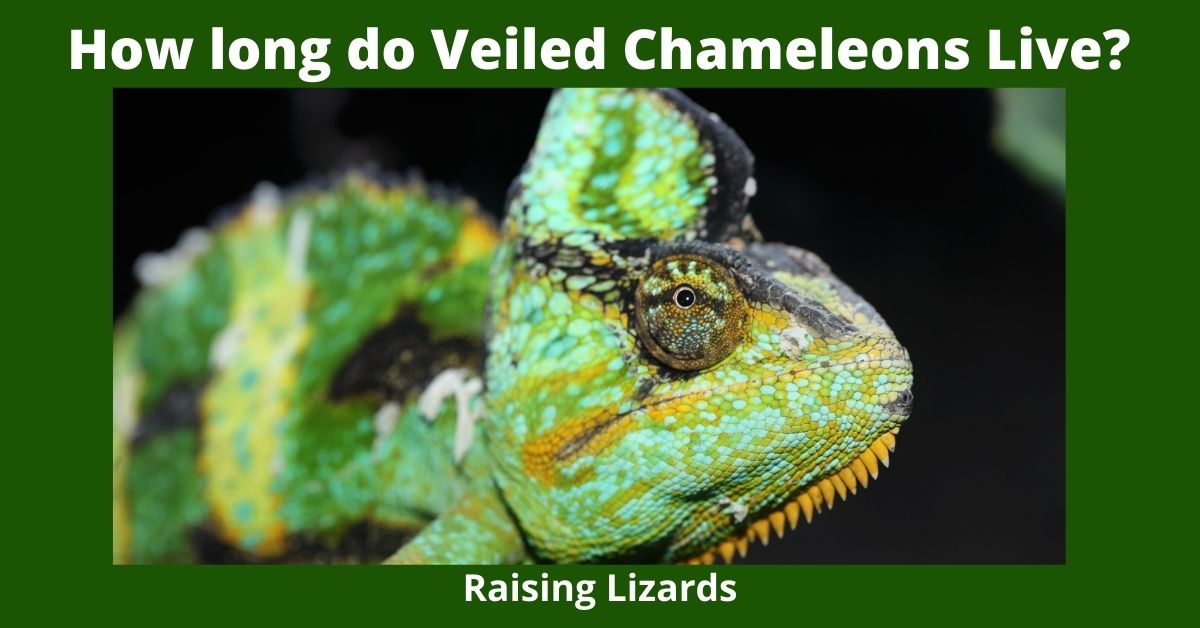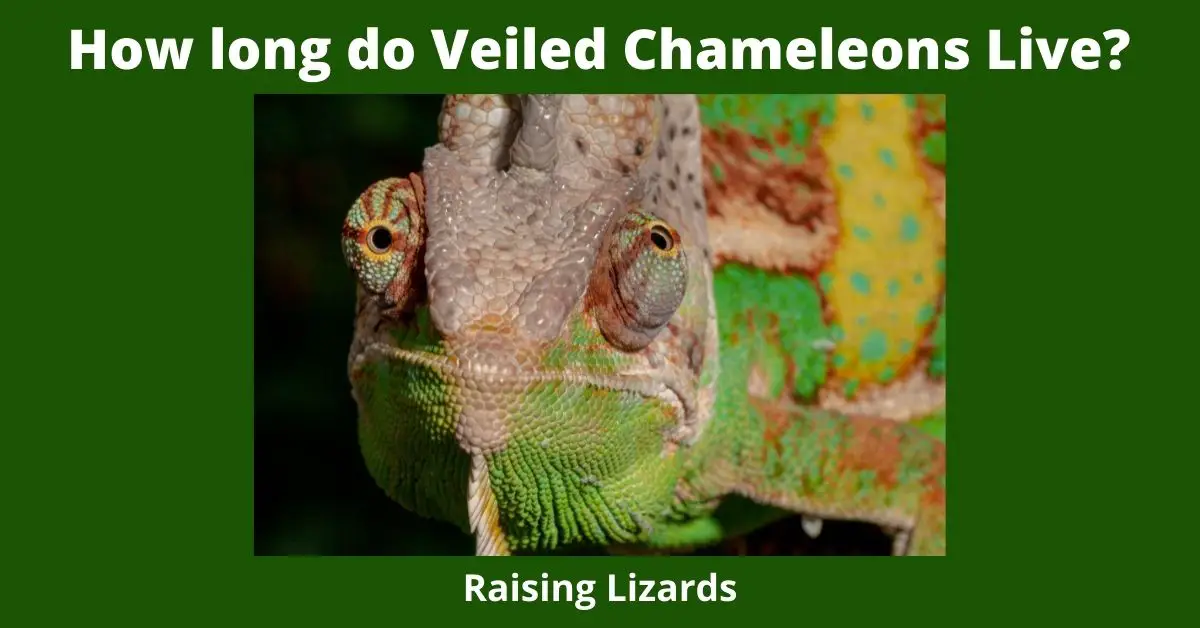The average lifespan of a veiled chameleon is around six to eight years in captivity, but some have been known to reach twelve years or more. This is due to a number of factors such as a controlled environment, a balanced diet, and lack of stress. Captive-bred animals typically experience less stress due to not having to worry about being preyed upon or environmental factors. In addition, most pet chameleons receive regular vet
How long do Veiled Chameleons Live?
Veiled Chameleons are one of the most popular chameleon species in captivity. Their natural habitat is in Yemen, Saudi Arabia, and other parts of the Middle East. They originate from Africa and can grow up to 20 inches long. Veiled Chameleons require a lot of care and attention to ensure they live a healthy life. This blog post covers everything you need to know about Veiled Chameleons, including their average lifespan, what they eat, how much exercise they need each day, and more! Jump to Are Chameleons Hard to Take Care Of? Ultimate Guide
How Long Do Veiled Chameleons Live?
Veiled chameleons can live for up to 15 years in captivity, though the average lifespan is around eight years. In the wild, veiled chameleons have been known to live for up to six years. How long do Veiled Chameleons Live?
One of the most important things you can do to help your veiled chameleon live a long and healthy life is to provide a suitable environment. Make sure your chameleon has plenty of branches and plants to climb on and hide in, as well as a basking area with a heat lamp. Be sure to also keep the temperature and humidity levels in their enclosure consistent.
How Long Do Veiled Chameleons Live In The Wild?
Veiled chameleons can live up to six years in the wild. They are vulnerable to predation and their lifespan may be shortened by disease or environmental factors, but they have been known to reach old age in their natural habitat. Veiled chameleon hatchlings usually don’t survive more than a year in the wild, although some make it to two or three years old. Females tend to live longer than males.
Wild Chameleons Lifespans are shorter because
- Hatching Loss- Most chameleon species hatch in very high numbers, and many of the young will die before they mature.
- Mortality During The First Year- Many animals that aren’t preyed upon as juveniles still succumb to disease or starvation during their first winter. Some animals don’t reach maturity for several years, so this time period accounts for a large loss in lifespan.
- Adult Mortality- Once an animal reaches adulthood it is usually safe from predation; however there are still numerous factors such as climate change and habitat degradation which can affect adult survival and decrease overall lifespan
- Predators – the predators of Chameleons are many and varied, some of which are the chameleon’s prey items as well.
- Parasites-Chameleons can be infected by a variety of parasites that can lead to reduced lifespan if left untreated.
- Diseases- Chameleons are also susceptible to various diseases that may shorten their lifespan.
- Environmental Hazards-Many hazards in the environment such as fires, floods, and chemical spills can kill chameleons or decrease their lifespan if they succumb to the effects.
Veiled chameleons are interesting creatures and make charming pets. If you’re interested in learning more about them, please visit our website or contact us for more information. Thanks for reading!

How Long Do Veiled Chameleons Live As A Pet?
The average lifespan of a veiled chameleon in captivity is about six to eight years, but some have been known to live as long as twelve years. Captive-bred animals tend to have a longer lifespan than those taken from the wild. This may be because they are not subject to the same environmental and predation pressures as their wild counterparts.
Pet Chameleons live longer than their wild counterparts.
The average lifespan of a pet chameleon is around five to seven years. However, some veiled chameleons have been known to live up to ten years or more in captivity.
Reasons Being
- Controlled Environment – Ideal temperature and humidity levels are maintained
- Diet – They have a balanced diet that is nutritious
- No Stress – As opposed to being in the wild where they can be stressed by predators, humans provide a safe place for them to live.
- Healthy Living – Most pet chameleons receive regular vet checkups which help maintain their health and extend their life span.
- The main reason why pet chameleons generally live longer than those found in the wild is because of the controlled environment they live in. Captive-bred animals typically experience less stress due to not having to worry about being preyed upon or environmental factors. In addition, most pet chameleons receive regular vet checkups, which help maintain their overall health and extend their life span.
- Supplements in the diet- calcium and multi-vitamins
- Clean Cages and Environment- which decreases the number of diseases they are exposed to
- If you’re interested in owning a chameleon, please contact us for more information. We would be happy to answer any questions you may have. Thanks for reading!
- Veiled Chameleons can live up to 12 years in captivity.
- The average lifespan of a veiled chameleon is around six to eight years in captivity, but some have been known to reach twelve years or more. This is due to a number of factors such as a controlled environment, a balanced diet, and lack of stress. Captive-bred animals typically experience less stress due to not having to worry about being preyed upon or environmental factors. In addition, most pet chameleons receive regular vet
Ways To Help Your Veiled Chameleon Live Longer?
Here are some suggestions to lengthen the lifespan of your Chameleon:
- Make sure your cage is large enough.
- Ensure you are feeding the right food at the appropriate times; it’s important to be consistent.
- Maintain an appropriate temperature for your specific species of chameleon (see below). Keep in mind that basking lamps should not be positioned directly over plants or branches inside the tank, as they can damage them. The best way to tell if a climate is too hot/cold is by using tongs and feeling with your hand! Do this during both day and night hours. Note: It may help to keep your Chamelion on a heating pad under their tank for about 12 hours per day during winter months when temperatures get cold at night time outside of his environment.
- Provide a hiding spot. This can be in the form of live plants, artificial vines/plants, or even a cardboard box.
- Offer your chameleon fresh water daily and mist their environment two to three times per day (more if it is very dry).
- Make sure there are no drafts near the tank.
- Remember: A healthy Chameleon equals a happy owner! Following these simple tips should help keep your little guy around for years to come. If you have any questions or concerns, please consult with an exotic animal veterinarian.
Temperature Guidelines For Veiled Chameleons:
Daytime Temperatures:
- The basking area should be about 95-100 degrees Fahrenheit . The ambient air temperature should be about 75-85 degrees Fahrenheit. This can drop down to 70-75 degrees at night time while the chameleon sleeps.
Nighttime Temperatures:
- The basking area will need to be lowered gradually until it reaches about 65-72 degrees Fahrenheit by morning when your Chameleon wakes up. The ambient air in his tank should not go below 60 degrees Fahrenheit. If you notice that he is shivering, then this means that temperatures are too low and a heat lamp or heating pad may need to be added under their enclosure for a certain number of hours per day if they do not have access to sunlight from outside their habitat (which would help keep them warm). They cannot control their body temperature as we can, so it is important to make sure they are comfortable!

Humidity Settings:
- 50%-70% humidity is a good range for Chameleons. If there’s not enough humidity in their tank, they will lick the water off of the leaves and walls which can cause health problems over time such as infections on their skin or respiratory issues. Too much humidity can be dangerous to them as well – it could promote fungal growth on plants and even inside of your chameleon’s mouth! It may also slow down digestion if you feed him insects that are low quality/not healthy for his species (i.e., never feed wild-caught prey).
- The best way to monitor these factors is by using a hygrometer, digital thermometer with a probe, and an infrared temperature gun. All three must be used simultaneously
- Monitor Live Feeder Insects – Make sure that the insects you are feeding your chameleon are healthy and parasite-free.
- Replace water bowls at least once a day.
- Clean the tank regularly – this includes scrubbing the inside of the tank with a reptile-safe soap every two weeks, changing out the substrate (or moss) every month, and vacuuming any leftover debris twice a week.
- Use a good quality UVB light – This is crucial for allowing your Chameleon to synthesize vitamin D which is essential for their health. Without it, they can develop metabolic bone disease which will severely impact their lifespan.
There are many ways to help keep your Veiled Chameleon healthy and extend his life! Following these tips should get you started
Classification of Veiled Chameleons – How long do Veiled Chameleons Live?
Kingdom: Animalia Phylum: Chordata Class: Reptilia Order: Squamata Family: Chamaeleonidae Genus: Chamaeleo


